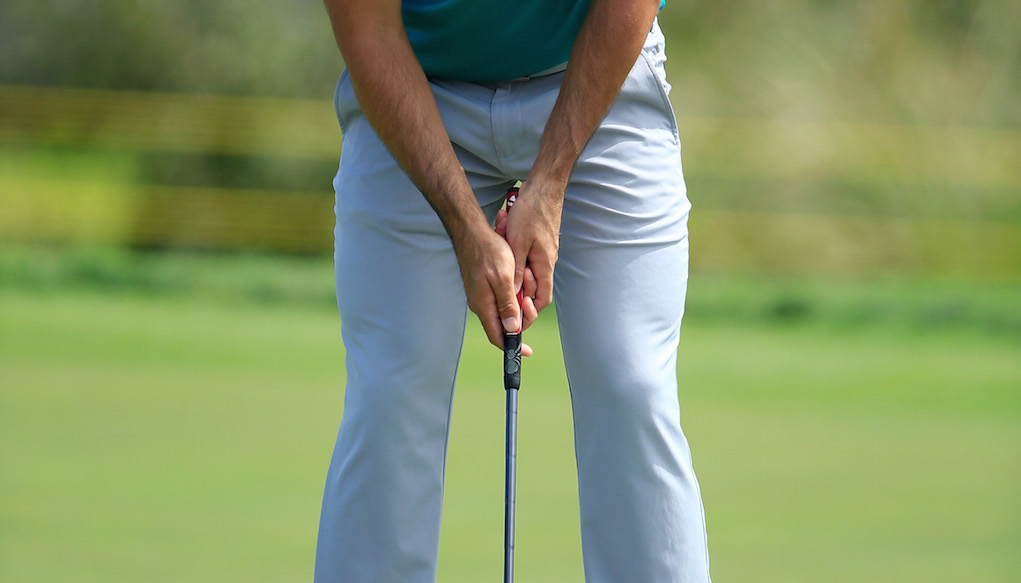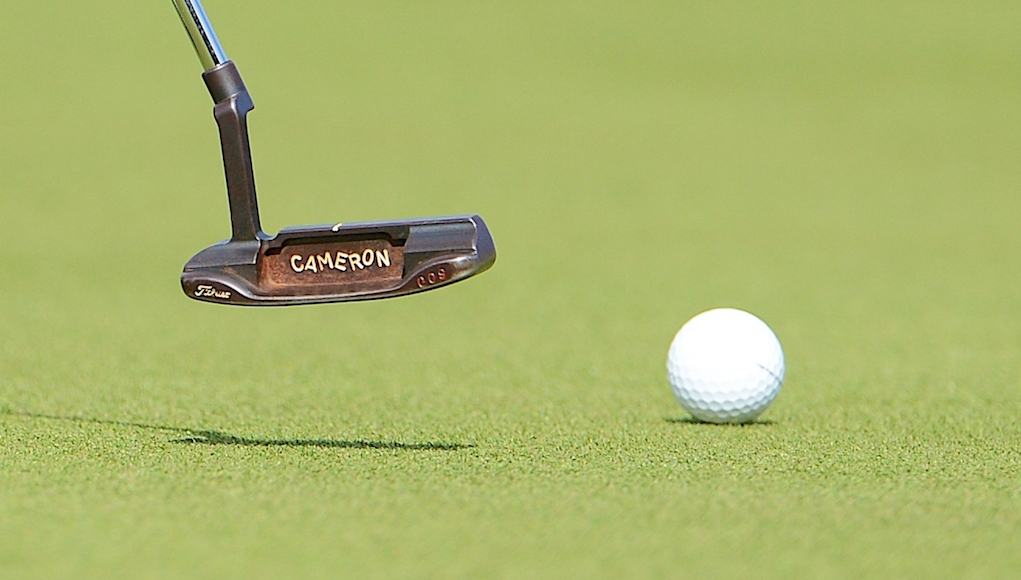Instruction
The illusion of the putter shaft, and why you should forward press

If you watch the vast majority of Tour players putt, you’ll notice that their hands start in front of the putter head at address, and this condition doesn’t vary throughout their stroke.
Most golfers don’t putt this way, though. Their hands start behind the putter head at address and tend to break down even more. They “slap” at the ball through impact and beyond, which is detrimental for both speed and direction control.
Golf instructors can agree that in order to be effective on the greens, golfers must have the putter shaft returning to neutral or even leaning forward at impact, allowing the hands to lead the blade throughout the stroke. Fundamentally, we know that the left hand controls the putter face and its direction, while the right hand controls the putter head and its effective loft (for right-handed golfers). These two factors together allow golfers to roll their putts more consistently.
The bottom line: if you do not lead the putter head with your hands on today’s fast green, you’ll struggle to be an effective putter.
The Illusion

Jordan Spieth keeps the back of his left hand stable and ahead of the putter head throughout his stroke.
So isn’t the solution as simple as forward pressing your hands during address. Why is that so hard? Well, when most amateurs forward press it’s almost never enough. That’s because they’re fighting an illusion.
That’s right, there’s an optical illusion that occurs when golfers look down from address at their hands and their putter shaft angle. It influences the breakdown of their impact alignments, and promotes a “slapping” action of the wrists and hands. It also encourages the putter head to swing past the hands, leaning the shaft away from the target at impact adding loft to the putter — not something we want.
Try It Yourself
To understand how putters are designed, place your putter flat on the ground, and up against the wall as pictured below. You will notice that the shaft leans away from the target.

If you still don’t buy it, take your setup in front of a full-length mirror and look down at the shaft of the putter. From your address position, you will swear that your putter shaft is even or slightly ahead of the golf ball. But when you look in the mirror you will see an entirely different picture. The putter shaft will actually be behind the putter head.
The Illusion Explained
Putter manufactures have built-in this backward leaning of the shaft and loft into the putter face to promote good mechanics (as well as other things) by forcing players to forward press their hands at address.
This was and still is a great idea, but the problem is that it causes an illusion, leading golfers to believe that their hands are pressed forward more than they actually are. This means that when the shaft is set in a forward-leaning position, the hands are really just over the top of the putter head, not in front of the blade as it looks visually from above.
How to Overcome the Illusion
Most golfers would be better off if they forward pressed their hands too much, rather than too little at address with their putter. This way, there is more room for error if something does breakdown.
A good rule of thumb is to always point the butt end of the putter shaft at the first belt loop on the target side of your belt buckle. As you look down, you may think you have the putter shaft pointed too far toward the hole, but when you look into your mirror you will find that it is only slightly forward leaning. This is the most desirable position for you to roll a putt.
Use a mirror to help you understand of the illusion of the putter shaft. I promise it will give you better control over your line and speed, and knowing you’re set up correctly will give you more confidence on the greens, too.
Don’t be fooled by the illusion.
Instruction
The Wedge Guy: Beating the yips into submission

There may be no more painful affliction in golf than the “yips” – those uncontrollable and maddening little nervous twitches that prevent you from making a decent stroke on short putts. If you’ve never had them, consider yourself very fortunate (or possibly just very young). But I can assure you that when your most treacherous and feared golf shot is not the 195 yard approach over water with a quartering headwind…not the extra tight fairway with water left and sand right…not the soft bunker shot to a downhill pin with water on the other side…No, when your most feared shot is the remaining 2- 4-foot putt after hitting a great approach, recovery or lag putt, it makes the game almost painful.
And I’ve been fighting the yips (again) for a while now. It’s a recurring nightmare that has haunted me most of my adult life. I even had the yips when I was in my 20s, but I’ve beat them into submission off and on most of my adult life. But just recently, that nasty virus came to life once again. My lag putting has been very good, but when I get over one of those “you should make this” length putts, the entire nervous system seems to go haywire. I make great practice strokes, and then the most pitiful short-stroke or jab at the ball you can imagine. Sheesh.
But I’m a traditionalist, and do not look toward the long putter, belly putter, cross-hand, claw or other variation as the solution. My approach is to beat those damn yips into submission some other way. Here’s what I’m doing that is working pretty well, and I offer it to all of you who might have a similar affliction on the greens.
When you are over a short putt, forget the practice strokes…you want your natural eye-hand coordination to be unhindered by mechanics. Address your putt and take a good look at the hole, and back to the putter to ensure good alignment. Lighten your right hand grip on the putter and make sure that only the fingertips are in contact with the grip, to prevent you from getting to tight.
Then, take a long, long look at the hole to fill your entire mind and senses with the target. When you bring your head/eyes back to the ball, try to make a smooth, immediate move right into your backstroke — not even a second pause — and then let your hands and putter track right back together right back to where you were looking — the HOLE! Seeing the putter make contact with the ball, preferably even the forward edge of the ball – the side near the hole.
For me, this is working, but I am asking all of you to chime in with your own “home remedies” for the most aggravating and senseless of all golf maladies. It never hurts to have more to fall back on!
Instruction
Looking for a good golf instructor? Use this checklist

Over the last couple of decades, golf has become much more science-based. We measure swing speed, smash factor, angle of attack, strokes gained, and many other metrics that can really help golfers improve. But I often wonder if the advancement of golf’s “hard” sciences comes at the expense of the “soft” sciences.
Take, for example, golf instruction. Good golf instruction requires understanding swing mechanics and ball flight. But let’s take that as a given for PGA instructors. The other factors that make an instructor effective can be evaluated by social science, rather than launch monitors.
If you are a recreational golfer looking for a golf instructor, here are my top three points to consider.
1. Cultural mindset
What is “cultural mindset? To social scientists, it means whether a culture of genius or a culture of learning exists. In a golf instruction context, that may mean whether the teacher communicates a message that golf ability is something innate (you either have it or you don’t), or whether golf ability is something that can be learned. You want the latter!
It may sound obvious to suggest that you find a golf instructor who thinks you can improve, but my research suggests that it isn’t a given. In a large sample study of golf instructors, I found that when it came to recreational golfers, there was a wide range of belief systems. Some instructors strongly believed recreational golfers could improve through lessons. while others strongly believed they could not. And those beliefs manifested in the instructor’s feedback given to a student and the culture created for players.
2. Coping and self-modeling can beat role-modeling
Swing analysis technology is often preloaded with swings of PGA and LPGA Tour players. The swings of elite players are intended to be used for comparative purposes with golfers taking lessons. What social science tells us is that for novice and non-expert golfers, comparing swings to tour professionals can have the opposite effect of that intended. If you fit into the novice or non-expert category of golfer, you will learn more and be more motivated to change if you see yourself making a ‘better’ swing (self-modeling) or seeing your swing compared to a similar other (a coping model). Stay away from instructors who want to compare your swing with that of a tour player.
3. Learning theory basics
It is not a sexy selling point, but learning is a process, and that process is incremental – particularly for recreational adult players. Social science helps us understand this element of golf instruction. A good instructor will take learning slowly. He or she will give you just about enough information that challenges you, but is still manageable. The artful instructor will take time to decide what that one or two learning points are before jumping in to make full-scale swing changes. If the instructor moves too fast, you will probably leave the lesson with an arm’s length of swing thoughts and not really know which to focus on.
As an instructor, I develop a priority list of changes I want to make in a player’s technique. We then patiently and gradually work through that list. Beware of instructors who give you more than you can chew.
So if you are in the market for golf instruction, I encourage you to look beyond the X’s and O’s to find the right match!
Instruction
What Lottie Woad’s stunning debut win teaches every golfer

Most pros take months, even years, to win their first tournament. Lottie Woad needed exactly four days.
The 21-year-old from Surrey shot 21-under 267 at Dundonald Links to win the ISPS Handa Women’s Scottish Open by three shots — in her very first event as a professional. She’s only the third player in LPGA history to accomplish this feat, joining Rose Zhang (2023) and Beverly Hanson (1951).
But here’s what caught my attention as a coach: Woad didn’t win through miraculous putting or bombing 300-yard drives. She won through relentless precision and unshakeable composure. After watching her performance unfold, I’m convinced every golfer — from weekend warriors to scratch players — can steal pages from her playbook.
Precision Beats Power (And It’s Not Even Close)
Forget the driving contests. Woad proved that finding greens matters more than finding distance.
What Woad did:
• Hit it straight, hit it solid, give yourself chances
• Aimed for the fat parts of greens instead of chasing pins
• Let her putting do the talking after hitting safe targets
• As she said, “Everyone was chasing me today, and managed to maintain the lead and played really nicely down the stretch and hit a lot of good shots”
Why most golfers mess this up:
• They see a pin tucked behind a bunker and grab one more club to “go right at it”
• Distance becomes more important than accuracy
• They try to be heroic instead of smart
ACTION ITEM: For your next 10 rounds, aim for the center of every green regardless of pin position. Track your greens in regulation and watch your scores drop before your swing changes.
The Putter That Stayed Cool Under Fire
Woad started the final round two shots clear and immediately applied pressure with birdies at the 2nd and 3rd holes. When South Korea’s Hyo Joo Kim mounted a charge and reached 20-under with a birdie at the 14th, Woad didn’t panic.
How she responded to pressure:
• Fired back with consecutive birdies at the 13th and 14th
• Watched Kim stumble with back-to-back bogeys
• Capped it with her fifth birdie of the day at the par-5 18th
• Stayed patient when others pressed, pressed when others cracked
What amateurs do wrong:
• Get conservative when they should be aggressive
• Try to force magic when steady play would win
• Panic when someone else makes a move
ACTION ITEM: Practice your 3-6 foot putts for 15 minutes after every range session. Woad’s putting wasn’t spectacular—it was reliable. Make the putts you should make.
Course Management 101: Play Your Game, Not the Course’s Game
Woad admitted she couldn’t see many scoreboards during the final round, but it didn’t matter. She stuck to her game plan regardless of what others were doing.
Her mental approach:
• Focused on her process, not the competition
• Drew on past pressure situations (Augusta National Women’s Amateur win)
• As she said, “That was the biggest tournament I played in at the time and was kind of my big win. So definitely felt the pressure of it more there, and I felt like all those experiences helped me with this”
Her physical execution:
• 270-yard drives (nothing flashy)
• Methodical iron play
• Steady putting
• Everything effective, nothing spectacular
ACTION ITEM: Create a yardage book for your home course. Know your distances to every pin, every hazard, every landing area. Stick to your plan no matter what your playing partners are doing.
Mental Toughness Isn’t Born, It’s Built
The most impressive part of Woad’s win? She genuinely didn’t expect it: “I definitely wasn’t expecting to win my first event as a pro, but I knew I was playing well, and I was hoping to contend.”
Her winning mindset:
• Didn’t put winning pressure on herself
• Focused on playing well and contending
• Made winning a byproduct of a good process
• Built confidence through recent experiences:
- Won the Women’s Irish Open as an amateur
- Missed a playoff by one shot at the Evian Championship
- Each experience prepared her for the next
What this means for you:
• Stop trying to shoot career rounds every time you tee up
• Focus on executing your pre-shot routine
• Commit to every shot
• Stay present in the moment
ACTION ITEM: Before each round, set process goals instead of score goals. Example: “I will take three practice swings before every shot” or “I will pick a specific target for every shot.” Let your score be the result, not the focus.
The Real Lesson
Woad collected $300,000 for her first professional victory, but the real prize was proving that fundamentals still work at golf’s highest level. She didn’t reinvent the game — she simply executed the basics better than everyone else that week.
The fundamentals that won:
• Hit more fairways
• Find more greens
• Make the putts you should make
• Stay patient under pressure
That’s something every golfer can do, regardless of handicap. Lottie Woad just showed us it’s still the winning formula.
FINAL ACTION ITEM: Pick one of the four action items above and commit to it for the next month. Master one fundamental before moving to the next. That’s how champions are built.
PGA Professional Brendon Elliott is an award-winning coach and golf writer. You can check out his writing work and learn more about him by visiting BEAGOLFER.golf and OneMoreRollGolf.com. Also, check out “The Starter” on RG.org each Monday.
Editor’s note: Brendon shares his nearly 30 years of experience in the game with GolfWRX readers through his ongoing tip series. He looks forward to providing valuable insights and advice to help golfers improve their game. Stay tuned for more Tips!





















Myths as Facts?
Aug 6, 2019 at 5:12 am
A lot of myths being repeated here. A forward press is a triggering device, nothing more. It takes maybe .8 degrees of loft away, so a 4 degree club is more than fine. I’m amazed at the poor quality of this article and the comments supporting it. It seems because someone works with Trackman people assume they have studied this, but certainly this is one of the most ill informed articles I’ve seen on this topic. Ask Frank Thomas. As Geoff Mangum. Ask Ralph Maltby. They will all set it straight.
EgdewRich
Feb 27, 2017 at 7:26 am
Combine Tom’s comments and analysis with Dave Stockton videos and written work and you may find a formula for improved rolling of the ball! I find attaching two longer tees to the heel and toe helps in practice since “seeing loft” helps me see the impact moment that produces a tight roll. Try gluing two quarters together for a practice ball
marker and resting the putter head on them before starting the stroke helps align the “vertical” sweet spot with the impact point on the ball. Try with a Nike Ping or Odyssey textured surface putter face! Putt to a 5 inch wide block of wood and work on the tight roll and just hitting the woodblock!
jc
Jan 16, 2017 at 2:25 pm
this works very well..I have the new golf pride overside piston grip on my ping rustler and b54….I just set it down and it naturally fall into the postion in the article…I then step in so my body mathes the end of the club….then back and into the hole….works with either putter, a no arc and a slight arc…
REAL REASON...
Jan 5, 2017 at 8:44 am
The real reason is because putters are ill designed.
1. Loft causes the ball to be hit below the equater
2. This causes the ball to get airborne, have backspin, bounce and results in bad distance control
Good putters forward press to reduce loft (3* quickly becomes 0* or less).
The ball is then hit at the equator or higher.
“Topped” balls roll better
Putting is the only shot in golf you really don’t want to get airborne….
better hit at the equator or above… better forward press or have negative loft to start with.
mark c
Jan 19, 2017 at 7:05 am
not true – unless youre playing on marble greens you need the ball to initially get airborne to lift it above the slight sunken lie it will be in on the grass and get it rolling on the top
tom stickney
Jan 3, 2017 at 4:55 pm
23 years of full-time teaching…if you doubt this, go to your local putting green any busy saturday am
Steven
Jan 3, 2017 at 2:39 pm
Great Advice. I think many of us would benefit from looking in the mirror during parts of the swing to see what is really happening. Like they always say, feel is not real.
Alfredo Smith
Jan 2, 2017 at 1:32 pm
Awesome read! I use a forward press to avoid a static swing. That illusion check blew me away because it has always appeared that my hands are ahead at address before I started the press. After reading this article my forward press is giving me that much more confidence. Thanks Tom Stickney!
david
Jan 2, 2017 at 1:08 pm
I put a line on the ball and, if I see the line after I putt, I feel I have hit a good putt because it rolled end over end. Seems to me that’s all that matters. Am I wrong on that? If I could read greens worth a damn and hit the short ones hard enough, I might be a decent putter.
Deadeye
Jan 1, 2017 at 11:14 am
Going back to legal anchoring days, why were the long and belly putters so effective? It’s my impression there was no forward press in those strokes. At least not in mine.
Tcope
Dec 31, 2016 at 9:10 am
The best thing I ever did was actually get fitted for a putter. Specifcally an Edel. That putting fit session was eye opening. Instead of really changine stance, press etc. Just have a putter built to your EYES and how you see the ball and address it. Had my first sub 2 putts per round the other day.
PineStreetGolf
Dec 30, 2016 at 10:50 am
My coment didn’t get posted for some reason, so sorry if this is a double.
Where did you get the data that “most” golfers don’t forward press? Study? Could you link it?
Having your hands ahead of the putter is nice, I guess, but its all relative. If your putter has three degrees of loft and 2* of shaft lean and you press it’ll be awful. Its all relative. The full swing is relatively similar and governed by motion physics, so you can make generalizations, but the putting stroke is much smaller – “get your hands forward” might be absolutely awful advice for some people.
Where did you get the source for your comment that “most” need it? Is this just you making it up? Poll? Shotlink? The entire article is based on this sentence and there isn’t a whiff of authority to support it. I’m not saying its wrong, but if your going to solve a problem with an enitre article it would be nice if you first proved there was actually a problem to be solved – where did the data that “most” golfers do this come from?
Myths as Facts?
Aug 6, 2019 at 5:14 am
No one presses two degrees at impact, forward press typically results in a maximum of .8 degrees reduction in loft which is fine for a typical 4 degree putter. That’s not the issue here. However the issues here are indeed many, agreed.
PineStreetGolf
Dec 30, 2016 at 10:18 am
“Most golfers don’t putt this way, though. ”
This is from your article. How do you know this? Study, survey? Or did this come from your head? Curious.
Blanket golf advice “always forward press…” is generally bad, unless you actually have tendency numbers to back it up. Where did your “most” come from? are we talking 70%? 90% Its a whole lot different if your making up that 65% do it versus an actual study that shows 95% do it.
In fact, Pelz concluded in his book the exact opposite – “most” golfers *do* have a forward press at impact. Its just offset by too much body lean away from the target.
i’d really like to see some evidence for the “most don’t forward press” basis of this article. A forward press is relative. If you forward press and then your spine titlts backwards, you actually arn’t forward pressing at all. Its alot more interconnected than this article makes it seem.
Putting your hands forward is not the same thing as proper loft at impact.
JH
Dec 29, 2016 at 10:58 pm
garbage
RichEwen
Dec 30, 2016 at 6:07 am
…and the reason for your succinct comment is??
alexdub
Dec 30, 2016 at 12:01 pm
Hang in there man, you’ll find a job soon!
Lowell
Dec 29, 2016 at 7:05 pm
I had this experience today working with a new putter. I felt to me that if I just set the putter down the putter has a tendency to have a lean away from the target. I almost have to promote pressing my hands forward which looked better but will take some time to buy into. I felt like the feel of the putt felt more solid as compared to when I would step in and set the putter with its natural position as I saw it. Pretty significant to say the least. Knowing this now, I will stick with pressing my hands forward and get that solid consistent roll that I want.
Mr B
Dec 29, 2016 at 6:41 pm
Great read Tom. Quick questions: I feel like I seriously close the face when I try to fwd press. Looks so awkward at address.
Is this common and just an illusion? If not an illusion and problematic, any tips not to close down the face when using a fwd press?
Prime21
Dec 29, 2016 at 11:45 pm
Tape a tee to the face of the putter. If you press the putter properly, it will lean towards the hole. If you are truly closing it will turn inwards towards you. A proper press may very well look “closed” to you, but if you have a system to check it, you will be able to determine if what your eyes are telling you is true or simply different. You may also want to put a line on the front of the tee (facing the target) with a sharpie. If done properly you will never see it, if you’re closing it, it will come into vision.
MR B
Jan 3, 2017 at 12:46 pm
thank you. will give it a whirl
Job
Dec 29, 2016 at 5:25 pm
What about using this technique with a Seemore? When I do this, it exposes the red button on the riflescope and takes away the advantage of ensuring proper alignment, which was one of the big draws of that putter. I now see that I almost assuredly am behind the ball but maybe there is a compromise?
Dill Pickleson
Dec 29, 2016 at 8:30 pm
I use a seemore and arc stroke and don’t think forward press is necessary if you square the face. A device like SkyPro will tell you that. Seemore gives you the setup and feedback you need
Double Mocha Man
Dec 29, 2016 at 4:36 pm
What if I’m wearing Sansabelt trousers left over from the ’70’s? There are no belt loops.
Prime21
Dec 29, 2016 at 11:46 pm
+4
TexasSnowman
Dec 31, 2016 at 12:05 am
Just point the butt of the grip at the penguin logo on your shirt
mlb
Dec 29, 2016 at 3:35 pm
Thanks Tom this helps me a lo i have this problem.
Darrin
Dec 29, 2016 at 2:27 pm
Face square at impact is all that matters. I just focus on the putter face being perpendicular to my starting line, what the shaft is doing at that point is irrelevant.
Jason
Dec 29, 2016 at 1:24 pm
Typical putter lofts are 3.5 to 4 degrees, which is typically measured when the shaft is vertical, correct? If the first belt loop is two inches ahead of the vertical line the putter shaft is leaning forward by 3 degrees which reduces static loft by the same amount. So, wouldn’t I want a putter with five or six degrees of loft if the goal is to return to impact on a level path with three degrees of shaft lean?
If some accommodation is not made in the putter’s loft it seems like a lot of people would begin experiencing bouncing putts.
I would love to know your two cents..
tom stickney
Dec 29, 2016 at 1:50 pm
It all depends on how you deliver the puttershaft into impact…for this article I wanted people to understand only the basics of the “illusion.” Find someone with a SAM Puttlab or a Quintic in your area for the best static/dynamic loft fitting.
Dave R
Dec 29, 2016 at 1:21 pm
Very good and yes it works ,I’ve done it for years tought to me over 40 years ago by a very old and good friend.
Jay
Dec 29, 2016 at 12:59 pm
Good read!!
Philip
Dec 29, 2016 at 12:21 pm
Tom, indeed when you place the putter flat on the ground you will get backward shaft lean, but the face of the putter will also be leaning back and adding loft. I’ve never putted like that and don’t know anyone that does either. I putt with the club face square and flat to the ball which results in some natural forward shaft lean. When I placed the putter faces up against a square steel block I see just a bit of forward shaft lean and when I set up at address I see even a bit more forward shaft lean that matches the full-length mirror when I look up. If one allows the putter to naturally hang from their arms and then lines up the club face to the ball, they will have no choice but to have some forward shaft lean unless their setup is messed up. I do not see this is an optical illusion, but more of an issue of improper setup or not understanding how to use a tool “putter” properly.
tom stickney
Dec 29, 2016 at 12:35 pm
not always…
Tom
Dec 29, 2016 at 11:48 am
Great article. And this technique works.